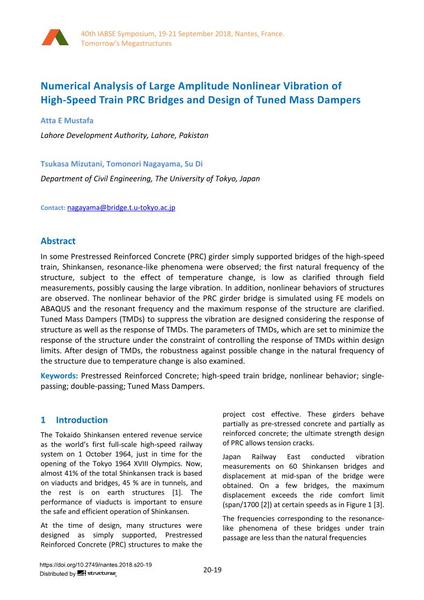Numerical Analysis of Large Amplitude Nonlinear Vibration of High-Speed Train PRC Bridges and Design of Tuned Mass Dampers

|
|
|||||||||||
Bibliografische Angaben
| Autor(en): |
Atta E. Mustafa
(Lahore Development Authority, Lahore, Pakistan)
Tsukasa Mizutani (Department of Civil Engineering, The University of Tokyo, Japan) Tomonori Nagayama (Department of Civil Engineering, The University of Tokyo, Japan) Su Di (Department of Civil Engineering, The University of Tokyo, Japan) |
||||
|---|---|---|---|---|---|
| Medium: | Tagungsbeitrag | ||||
| Sprache(n): | Englisch | ||||
| Tagung: | IABSE Symposium: Tomorrow’s Megastructures, Nantes, France, 19-21 September 2018 | ||||
| Veröffentlicht in: | IABSE Symposium Nantes 2018 | ||||
|
|||||
| Seite(n): | S20-19 | ||||
| Anzahl der Seiten (im PDF): | 8 | ||||
| DOI: | 10.2749/nantes.2018.s20-19 | ||||
| Abstrakt: |
In some Prestressed Reinforced Concrete (PRC) girder simply supported bridges of the high-speed train, Shinkansen, resonance-like phenomena were observed; the first natural frequency of the structure, subject to the effect of temperature change, is low as clarified through field measurements, possibly causing the large vibration. In addition, nonlinear behaviors of structures are observed. The nonlinear behavior of the PRC girder bridge is simulated using FE models on ABAQUS and the resonant frequency and the maximum response of the structure are clarified. Tuned Mass Dampers (TMDs) to suppress the vibration are designed considering the response of structure as well as the response of TMDs. The parameters of TMDs, which are set to minimize the response of the structure under the constraint of controlling the response of TMDs within design limits. After design of TMDs, the robustness against possible change in the natural frequency of the structure due to temperature change is also examined. |
||||
| Stichwörter: |
nichtlineares Verhalten
|
||||
